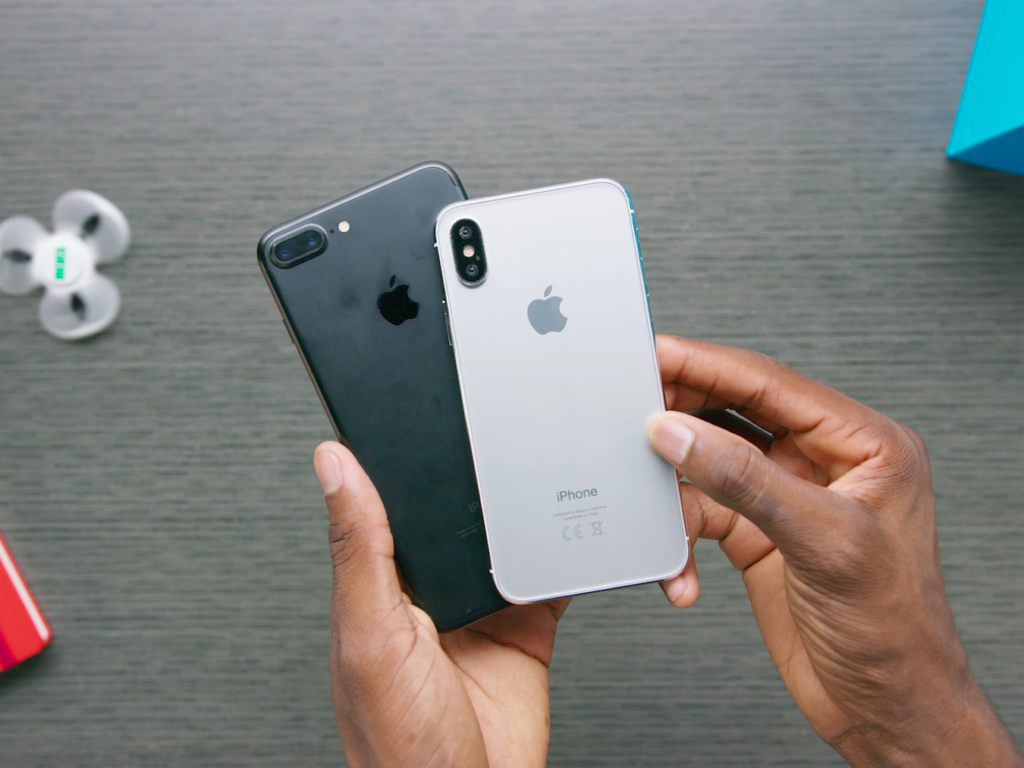The 10th anniversary Apple iPhone is here, and it’s called the iPhone X (pronounced “iPhone Ten”). The Cupertino, California-based company made it official at an event on the Apple Campus in the Steve Jobs Theater — and in our iPhone X review, we call it “the best iPhone ever.”
Indeed, Apple CEO Tim Cook called the new iPhone X “the biggest leap forward since the original iPhone,” and it’s easy to see why. The OLED display — an iPhone first — is called the Super Retina Display and measures 5.8 inches, with a resolution of 2,436 × 1,125 pixels. It features Dolby Vision and HDR10 for stunning high-contrast video playback, as well as TrueTone dynamic white-balance adjustment, a feature of the 10.5-inch iPad Pro and the new iPhone 8 models. The screen takes up the whole screen and there’s no home button — you unlock your phone with your face. Oh, and it’s water- and dust-resistant, and capable of charging wirelessly.
iPhone X pre-orders are slated to deliver on November 3, but many people found themselves having to wait until the end of November or December to receive one. It looks like Christmas came early, though, as The Verge confirms there are multiple reports of shipping estimates moving up as early as November 6. You should check your shipping estimate from Apple to see if your device is arriving sooner.
The iPhone X costs $1,000, and it’s available in limited stock at Apple stores, carriers, and retailers on November 3. You can nab one in either 64GB or 256GB, but the latter will cost $1,150. If you’re planning on picking one up at a store, Apple recommends arriving early — you may want to consider waiting on line the night before or early in the morning.
Some carriers, like Sprint, are cutting customers a discount. New and existing customers on the carrier’s Sprint Flex plan will be able to get a 64GB iPhone for $22.22 per month for 18 months ($400) with an eligible trade-in. For a full list of iPhone X prices and pre-order information, check out our iPhone X buying guide.
The iPhone X was the third phone announced by Apple on September 12, joining the iPhone 8 and 8 Plus. It followed the Series 3 Apple Watch, which comes with built-in cellular connectivity.
OLED display
Apple released a support document about the iPhone X’s OLED display. The document states users may see slight shifts in color when looking at the screen from an angle. Apple also warned that users may experience screen burn-in with extended use of the phone.
But most recently, DisplayMate — the company that makes professional-grade software for display calibration — published its detailed results for the iPhone X. According to its testing, the iPhone X has the best smartphone display on the market. Based on lab tests and measurements, the device earned DisplayMate’s A-plus rating — which is the highest ever. The results noted that the X had close to “textbook perfect calibration and performance,” along with the highest absolute color accuracy, highest full-screen brightness for OLED smartphones, among others.
Warranty information
With the iPhone X pre-orders now live, MacRumors spotted that Apple released pricing information about the phone’s repairs. In the U.S., Apple will charge you a flat rate of $280 for iPhone X screen repairs and $550 for any other damages. If it’s a manufacturing defect, then it’s covered by Apple’s standard one-year warranty.
Pricing also varies depending what country you’re in:
- U.K: 286 euros for screen repairs, 556 euros for other damage
- Australia: $420 for screen repairs, $820 for other damage
- Canada: $360 for screen repairs, $710 for other damage
- Germany: 321 euros for screen repairs, 611 euros for other damage
But these prices are only applicable to those who don’t purchase AppleCare+ for the iPhone X. AppleCare+ is optional, but it extends an iPhone’s coverage to two years based on the original purchase date of the device. If you decide to purchase the extended warranty plan, then screen repairs will only cost you $30 and any other damages will be $100.
Production woes reportedly hamper iPhone X supply
Apple will sell the iPhone X in 55 countries around the world. But there will be delays.
The iPhone X’s Face ID sensor is reportedly taking more time to assemble than expected, according to The Wall Street Journal, contributing to shipping delays. The problem lies in an “imbalance” between the so-called Romeo module, an infrared dot projector that beams more than 30,000 invisible dots to create a depth map of faces, and the Juliet module, which analyzes the pattern produced by those dots.
According to Bloomberg, it was earlier this fall that Apple realized production problems meant it wouldn’t have enough iPhone Xs for the holidays. Sources familiar to the situation say Apple’s solution was reportedly to let suppliers reduce the accuracy of the iPhone X’s Face ID feature. Lowering the requirements for its Face ID technology would permit the firm to speed up production. The change also means that it takes less time to test completed modules. But it’s still unclear how these changes will decrease the technology’s efficacy.
Following Bloomberg’s detailed report on Face ID accuracy being reduced, Apple responded to the claim. The company’s spokeswoman Trudy Muller said, “Bloomberg’s claim that it reduced the accuracy spec for Face ID is completely false and we expect Face ID to be the new gold standard for facial authentication.” Muller also assured users that both quality and accuracy of Face ID remains the same, and the chance of someone other than you unlocking your phone is still one in a million.
Camera, A11 Bionic chip, and AR
The iPhone X’s camera has a dual-lens 12-megapixel rear camera with dual optical image stabilization, consisting up of a wide-angle f/1.8 aperture lens and a telephoto f/2.4 aperture lens. The 7-megapixel front camera supports Portrait mode and has auto image stabilization and exposure control. Apple’s new image signal processor provides advanced pixel processing and a new color filter, and both cameras use the new Natural Lighting effect introduced on the iPhone 8 and ARKit augmented reality features. Finally, video has also been improved with 4K resolution movies at 60fps and slow-motion video at 240fps.
DxOMark — a website focused on assessing image quality for mobile phones, lenses, and camera sensors — recently evaluated the iPhone X. The site released its results, which indicate the device received an overall score of 97 out of 100 — the second-highest score in the DxOMark Mobile overall ranking. With the best Photo sub-score so far — 101 points — results stated the iPhone X is the top performer for stills. In comparison to the iPhone 8 Plus, DxOMark specifically pointed out the iPhone X’s improved telephoto lens led to higher results in Zoom, Exposure, Noise, Texture, and Artifacts.

The iPhone X retains the A11 Bionic chip from the iPhone 8, a 64-bit super efficient processor with a new Apple-designed graphics unit, which has 30 percent more speed than the existing unit. It has six cores and better performance than the A10 Fusion chip, and while Apple typically doesn’t publish RAM specifications, filings from China electronics regulator TENNA show the iPhone X has 3GB of RAM. Apple says the high-performance cores to provide a 25-percent speed increase and a 70 percent boost from the four performance cores.
Regarding battery life, the iPhone X lasts about two hours longer than the iPhone 7 Plus on a single charge. That’s not surprising; according to Chinese electronics regulator Tenaa’s filings, the iPhone X’s has a 2,716mAh battery, which isn’t far off from the iPhone 7 Plus’s 2,900mAh. It supports wireless charging via Qi-compatible accessories, and Apple will introduce a proprietary charging solution called AirPower early next year.
Face ID
Apple’s new facial recognition technology, Face ID, makes its debut on the iPhone X. It works using the TrueDepth camera system hidden in the notch at the top of the display. Glance at the iPhone X and it illuminates your face with an infrared dot array, allowing the infrared camera to identify it. It even works in the dark. Using the iPhone X’s six-core A11 Bionic processor paired with 3GB of RAM, a neural engine processes the image in real time, mapping the contours and shape of your face mathematically.
Apple claims Face ID isn’t confused by hairstyles, hats, or beards. According to Apple software chief Craig Federighi, the iPhone will be able to recognize your face through “most” sunglasses, too, as long as they let through enough infrared light. Protections against masks and pictures are in place, and face data is stored in the secure enclave inside the A11 Bionic chip.
Don’t worry about Face ID being less secure than other biometric systems; it’s not. The chance of someone other than you unlocking your phone with Touch ID is one in 50,000, Apple says, but for Face ID it’s one in a million. Apple Pay requires you to look at the phone when you go to pay, and it works with existing apps that use Touch ID for authentication.
On top of that, Apple has implemented some software protections against people stealing your phone and just holding it to your face to unlock it. For starters, if you don’t stare at the phone itself, it won’t unlock. And if you grip the buttons on both edges of the phone, the device will temporarily disable facial recognition.
If you remember when Apple first implemented Touch ID, you’ll remember some bumps and bugs at first — but many of those bugs shouldn’t exist with Face ID. In fact, developers won’t even have to worry about implementing it — if an app uses Touch ID, it will automatically also use Face ID. Craig Federighi, Apple’s senior vice president of software, said as much in an interview with John Gruber on Daring Fireball.
Update: DisplayMate publishes results of iPhone X testing, calls it the best smartphone display on the market.



